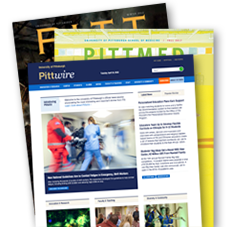Futuristic Electronics and Better Diplomacy Among the Focuses of Pitt-Involved Research for U.S. Defense Department
PITTSBURGH-High-density electronics of the future and more effective diplomacy are among the possible outcomes of a combined $2.7 million that two University of Pittsburgh researchers will receive as part of collaborative projects for the U.S. Department of Defense. The Multidisciplinary University Research Initiative (MURI) program-which supports basic research of interest to the Defense Department-will devote $200 million over the next five years to 34 multi-institutional projects, three of which involve Pitt.
Pitt professor Jeremy Levy in the Department of Physics and Astronomy in the School of Arts and Sciences was awarded $1.1 million as part of a five-year, $6.5 million project to investigate future applications of electron spin, which may allow for faster and less power-consuming information technology. Michael Lewis, a professor in the School of Information Sciences, will receive a total of nearly $1.5 million for two MURI projects totaling $13.75 million: One will evaluate the feasibility of a decentralized military communication system; another is meant to help military negotiators better cooperate with people of different cultures.
Levy will collaborate with researchers from four other universities to apply electron spin to organic semiconductors and other materials in an attempt to create devices that can store and transfer information with more density but by using less power. Electron spin-the interaction between spinning electrons and magnetic materials-is used in today's computer hard drives and allows highly sensitive sensors to probe the drive's minute magnetic domains. As a result, hard drives are smaller and maintain higher information density.
Levy and his colleagues want to extend these spin-based electronic effects in new ways and with new materials, providing the scientific basis for future technologies. Levy will use state-of-the-art optical and scanning probe techniques to investigate the properties of materials fabricated by his colleagues at the University of Iowa, the University of California at Berkeley, and New York University. Theoretical support will come from researchers at Iowa and the University of Missouri at Columbia.
Levy also will investigate further uses for a technique he developed and published in "Nature Materials" in March. He discovered how to switch, at will, the interface of two readily formed insulating materials from an electrical conductor to an insulator and back at nanoscale dimensions. Levy and his team created wires less than 4 nanometers wide at the interface of two insulators. These conducting nanostructures can subsequently be erased, rendering the interface an insulator once more. This adjustability holds promise for more powerful and compact information technologies, including ultra-high density information storage, reconfigurable logic devices, single-electron devices, and quantum computers.
Lewis will receive almost $600,000 from MURI to create methods for observing how cultural differences influence negotiation. Lewis specializes in human interaction with and through computers and machines, including virtual environments, human error, negotiation, and e-commerce. His work for MURI is part of a $6.25 million project to understand the dynamics of cooperation and negotiation-and the factors that lead to success or disaster. He will work with researchers from Carnegie Mellon University, the University of Michigan, Georgetown University, and the University of Southern California.
Because geographic and language barriers render cultural differences particularly difficult to observe, Lewis and his team at Pitt will develop a browser-based negotiation environment to offset distance and language. For example, language differences would be overcome by having subjects compose offers and arguments using lists and menus in their native tongue. Also, Webcams, microphones, and translators can help make interaction more personal. Once the negotiations are recorded, Lewis will provide them to the partner institutions to identify aspects of negotiation that are universal and unique to a particular culture and those that become significant in cross-cultural interaction. The project results will be used for training military negotiators.
Lewis also will receive nearly $1 million as part of a $7.5 million project involving researchers from Carnegie Mellon, Massachusetts Institute of Technology, Cornell University, and George Mason University to study the benefits and pitfalls of a decentralized military information network.
Their work will involve a developing military communication system that bucks the traditional hierarchy and instead shifts information processing and decision making to a peer-to-peer network outside the chain of command. This could allow soldiers and robots to better communicate and react in fast-changing situations on the ground. On the other hand, the lack of a central command to filter information could lead to confusion among soldiers. Lewis will evaluate the strengths and weaknesses of the proposed network as it relates to how teams of soldiers are able interact with the communication system itself.
The competitive MURI program received 104 proposals in 18 topics. The selected projects include 64 universities, which will receive a total of $19.7 million in fiscal year 2008. Panels of experts in the respective fields selected the projects based on scientific merit. For more information on the MURI awards, visit the Defense Department's Web site at www.defenselink.mil/releases/release.aspx?releaseid=11765.
###
3/31/08/tmw
Media Resources
Schools of the Health Sciences Media Relations
For more information about Pitt's schools of dental medicine, health and rehabilitation sciences, medicine, nursing, pharmacy, and public health, click here >
To locate stories from health science schools prior to 2013, visit the UPMC news archives »
Urgent Question?
University of Pittsburgh news reps are available to answer urgent media inquiries. Outside of regular business hours (Mon-Fri, 8:30 a.m.-5 p.m.), please email us at media@pitt.edu.
News reps for University of Pittsburgh Health Sciences schools can be reached outside of regular business hours through the paging operator at 1+412-647-2345.


